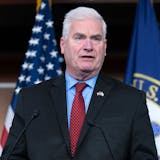Radiologists can look at an X-ray and determine fairly quickly whether the image they’re seeing is of a healthy person, or a sick one.
Similarly, hunters and other conservationists can examine the photograph accompanying this column — which I took after a recent late-season pheasant hunt — and assess the health of the land pictured and the type of wildlife it supports.
The snapshots suggest the landscape is healthy.
Enough grass, for example, is present to hold the soil together, enriching it with organic matter while preventing erosion and keeping nearby streams and wetlands clear of runoff.
Also, in spring and summer, the thick grass will be abuzz with insects, which will feed pheasants and songbirds, which in turn will be preyed upon by redtails and other hawks, as well as foxes and coyotes.
Thus, in the micro-environment pictured, a circle of life exists that is often unseen and even more often unappreciated — yet is as old as time itself.
And just as fleeting.
Because since statehood in 1858, more than 98% of Minnesota native grasslands have been plowed under, and in the state’s farmlands, almost as many wetlands have been lost.

